News
Diving Loch Long
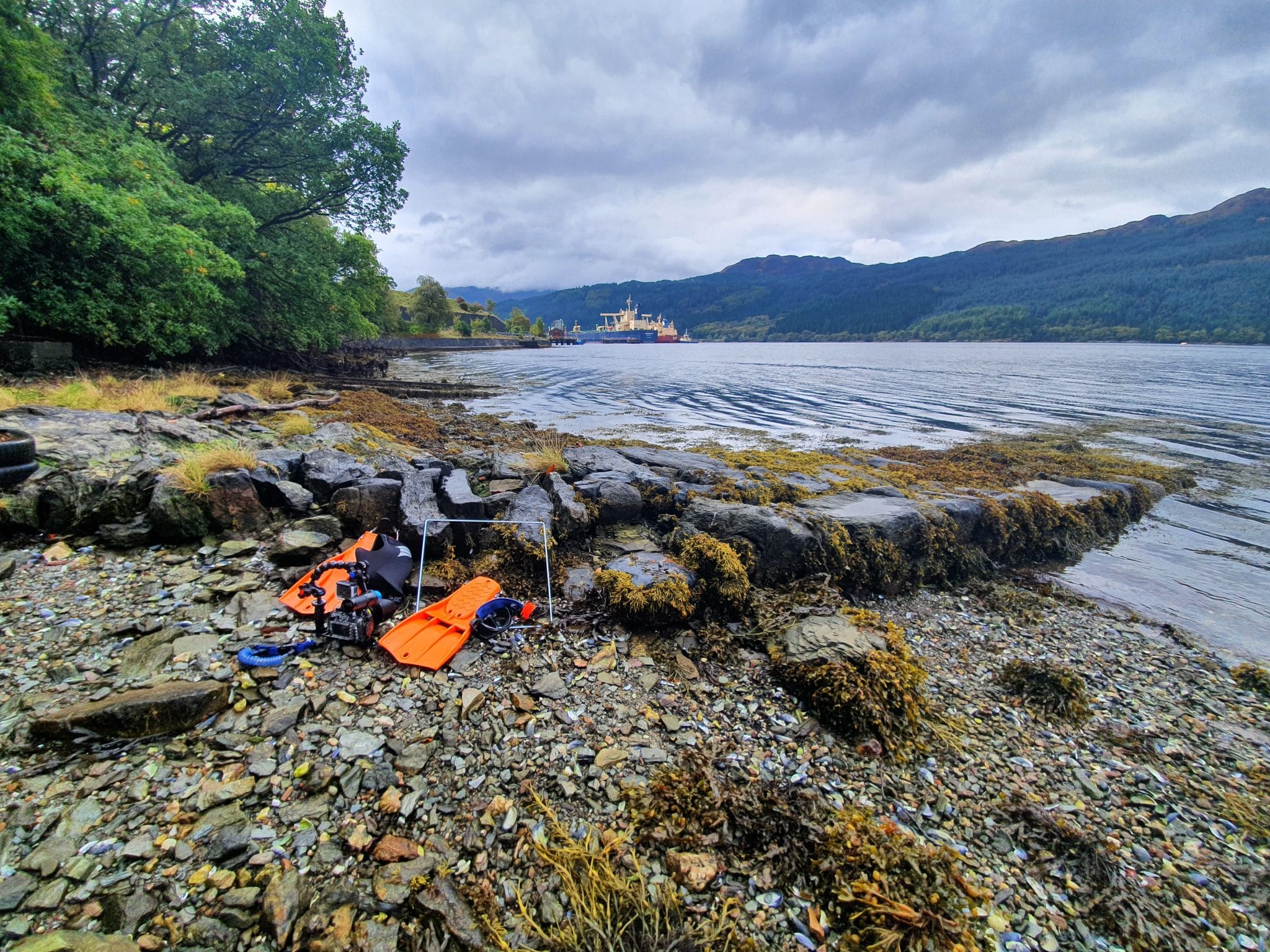
I’m not sure why, maybe it’s just me, but I think sometimes we overlook what we have right on our doorsteps. For some of us we can become indifferent, and in some cases outright loathsome, to things we see and experience regularly, not always fully appreciating what we have close by. When it comes to diving on the west coast of Scotland I think is particularly relevant in regards to Loch Long.
If you’re a diver from Scotland (who dives here obviously) it’s pretty much guaranteed you’ll have dived in Loch Long, whether it be for training/courses or “fun” dives. In fact, I think it’s safe to say if you’re a regular diver here, you’re probably a little fed up of diving in Loch Long. But when I sit down and really think about it, I begin to wonder if we actually take the loch for granted and don’t appreciate it as much as we should!
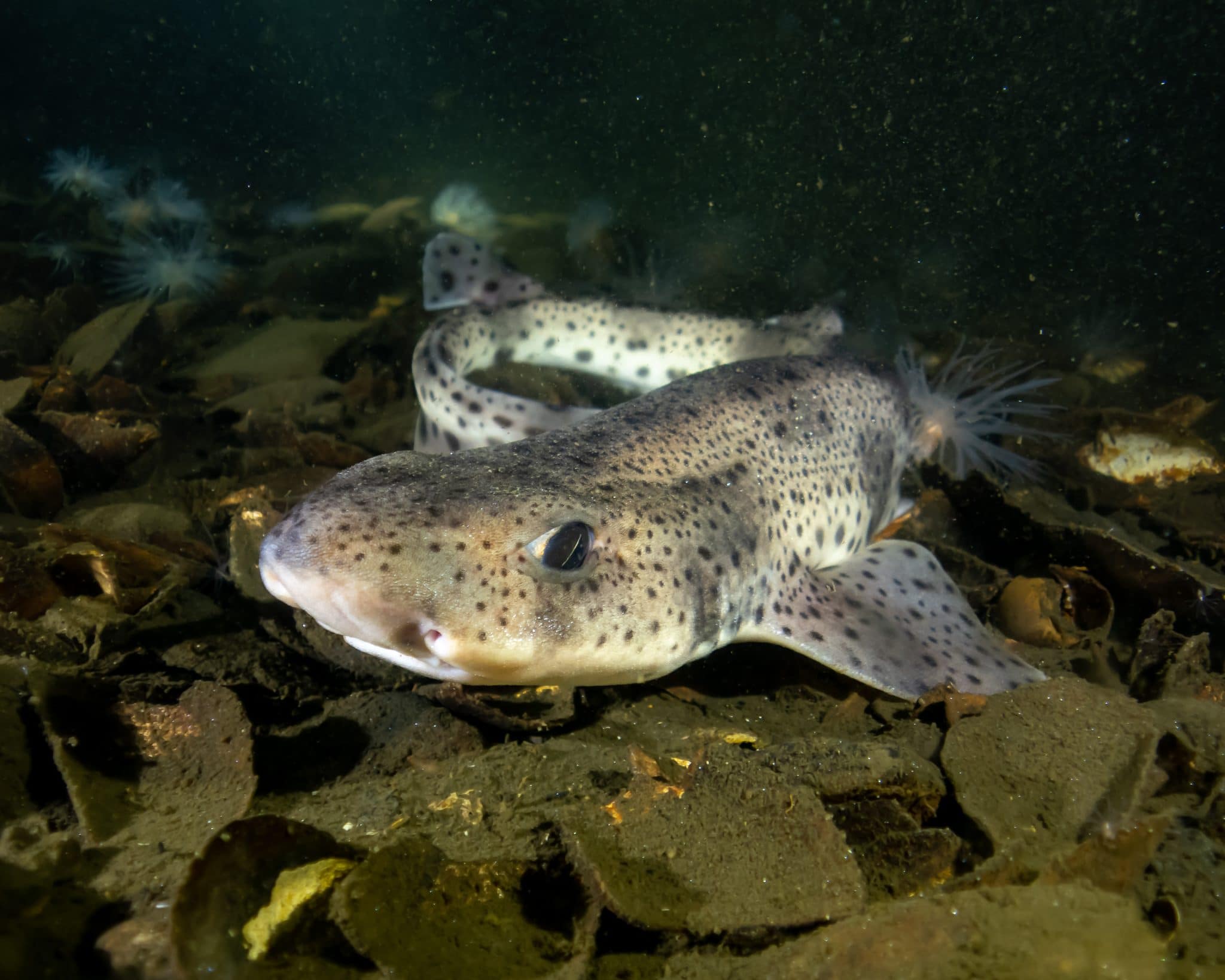
Although at 20 miles long Loch Long doesn’t get its name from its length, actually Loch Long in Gaelic translates to Ship Lake and the name dates back to 1263 when the Vikings saw Arrochar, at the top of the loch, as a key target from which they could drag their ships across land to attack the unprotected settlements of Tarbet.
Anyway… brief history lesson over, back to diving. If you do a quick check of Finstrokes you’ll see that there is no less than THIRTEEN dive sites in Loch Long, that’s a staggering number in one body of water and all within an hour’s drive from Glasgow City Centre. I’ll be honest, until I started researching this piece I didn’t actually realise there were so many, I’ll hold my hands up, I’m no expert by any stretch of the imagination and I’ve certainly not dived all thirteen.
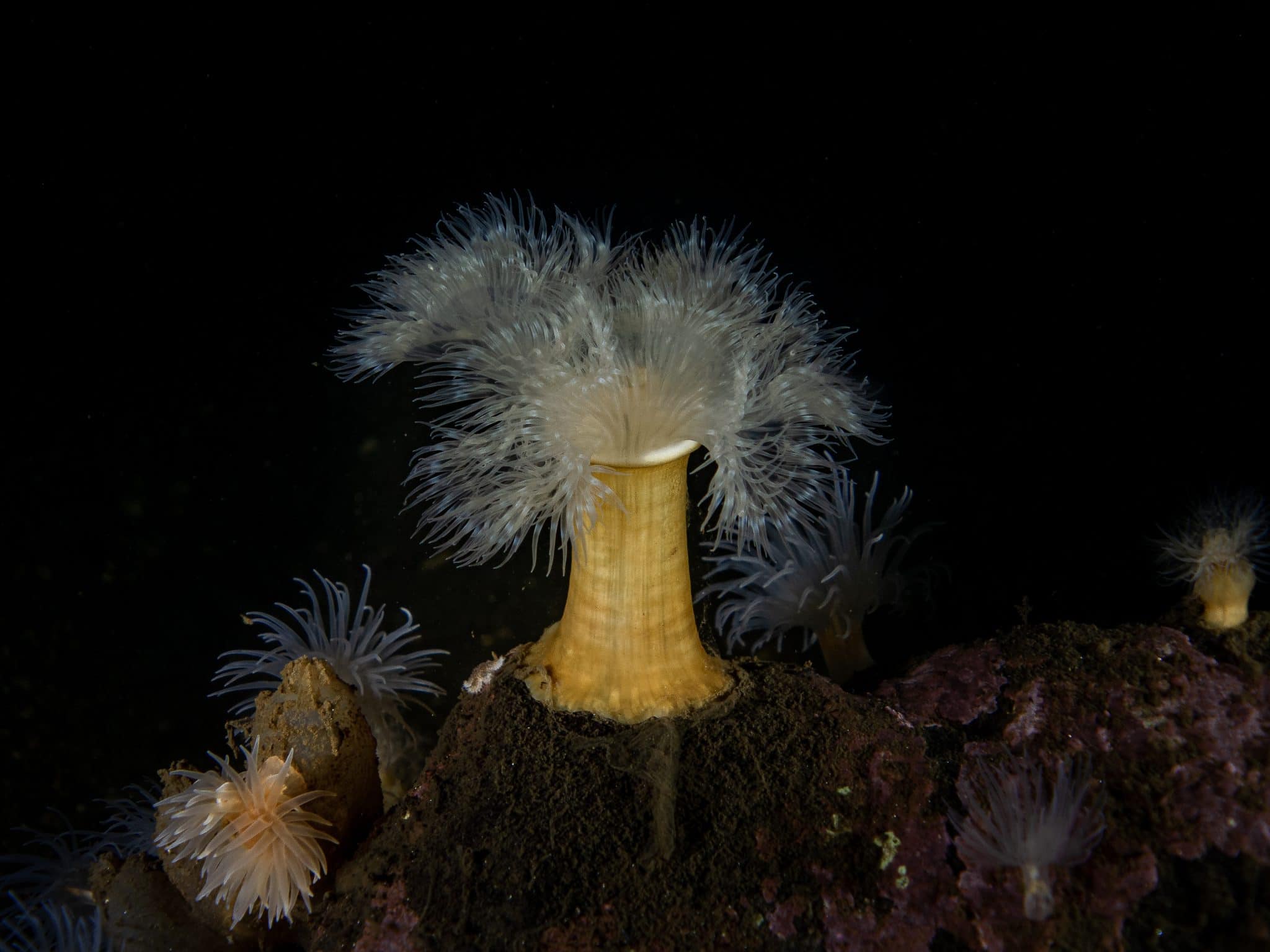
Of the sites, in my opinion, there are definitely four that stand out as and are definitely worth a visit if you are up this way.
As with sites around the country, every club/organisation/dive school seem to have their own names for each one, but I’ll try and give as many names as possible for each site.
Finnart/A-Frames
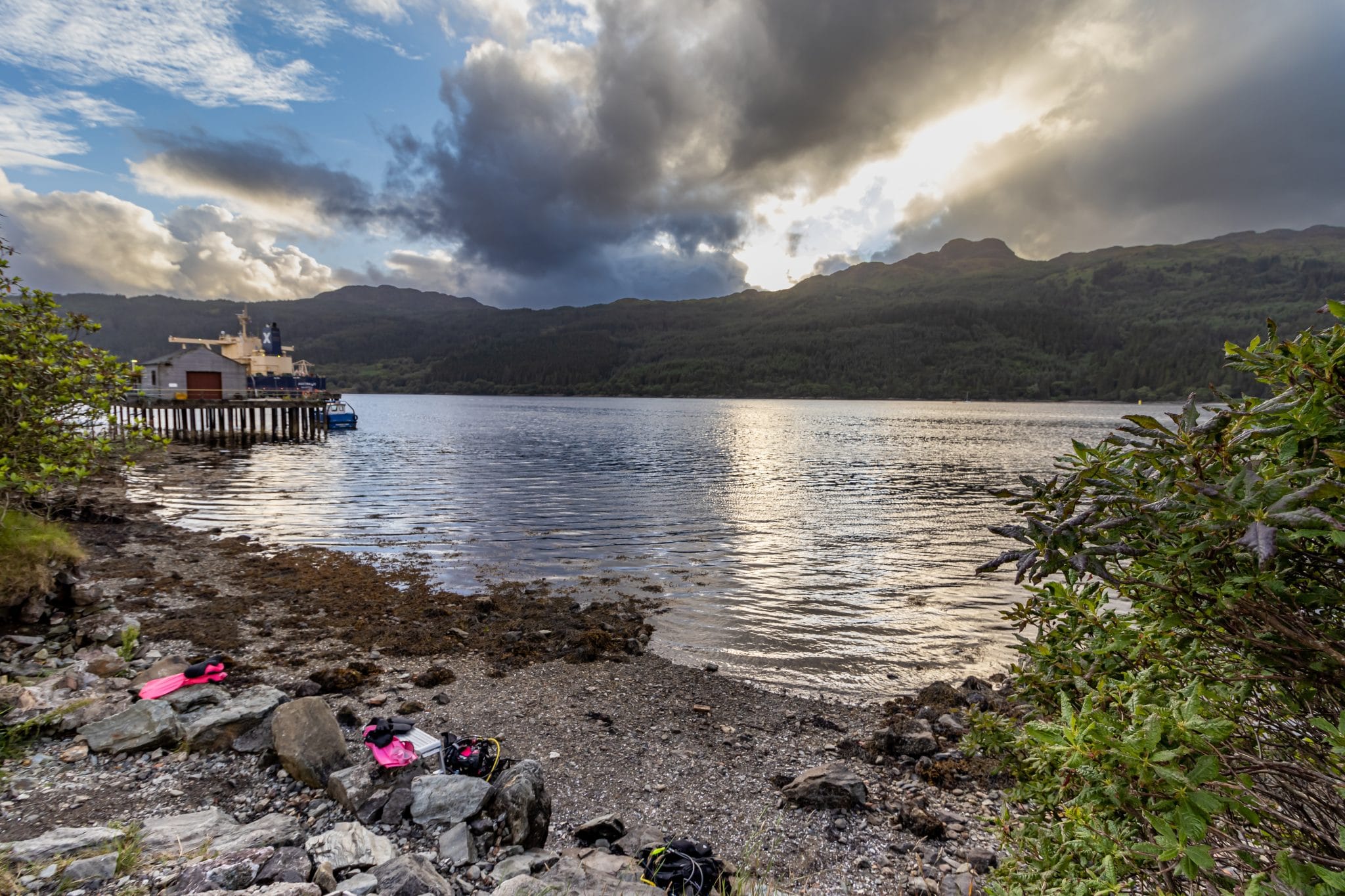
Finnart (sometimes referred to as A-Frames) is probably the most popular site in Loch Long, probably the most popular site in Scotland, and if not the number one, it’s definitely up there. Finnart was built by the Americans during the Second World War to offer a deep water oil terminal within the defensive ring of the Clyde.
Chances are if you’ve taken part in any training or courses here you’ll have at least done one dive at the ever popular A-Frames, but it’s not just for trainees. At A-Frames you’re met with an excellent carpark (which gets VERY busy in the summer weekends) and an entry that’s pretty good by many respects, though the small scramble down to the beach does require a little bit of care.
Once you dive beneath the surface you’re met with an extremely diverse site that has enough to satisfy the newest recruits taking their first breaths underwater, right the way up to the most hard-core experienced divers. With wreckage from the old pier to be found around 8 to 12m there is a huge amount of life clinging to it giving first time divers a superb introduction to the site. If depth isn’t really your thing, then you could spend a full dive in and around this debris field zig-zagging the slope and exploring all the nooks and crannies that are home to squat lobsters, edible crabs, velvet swimming crabs, the list goes on.
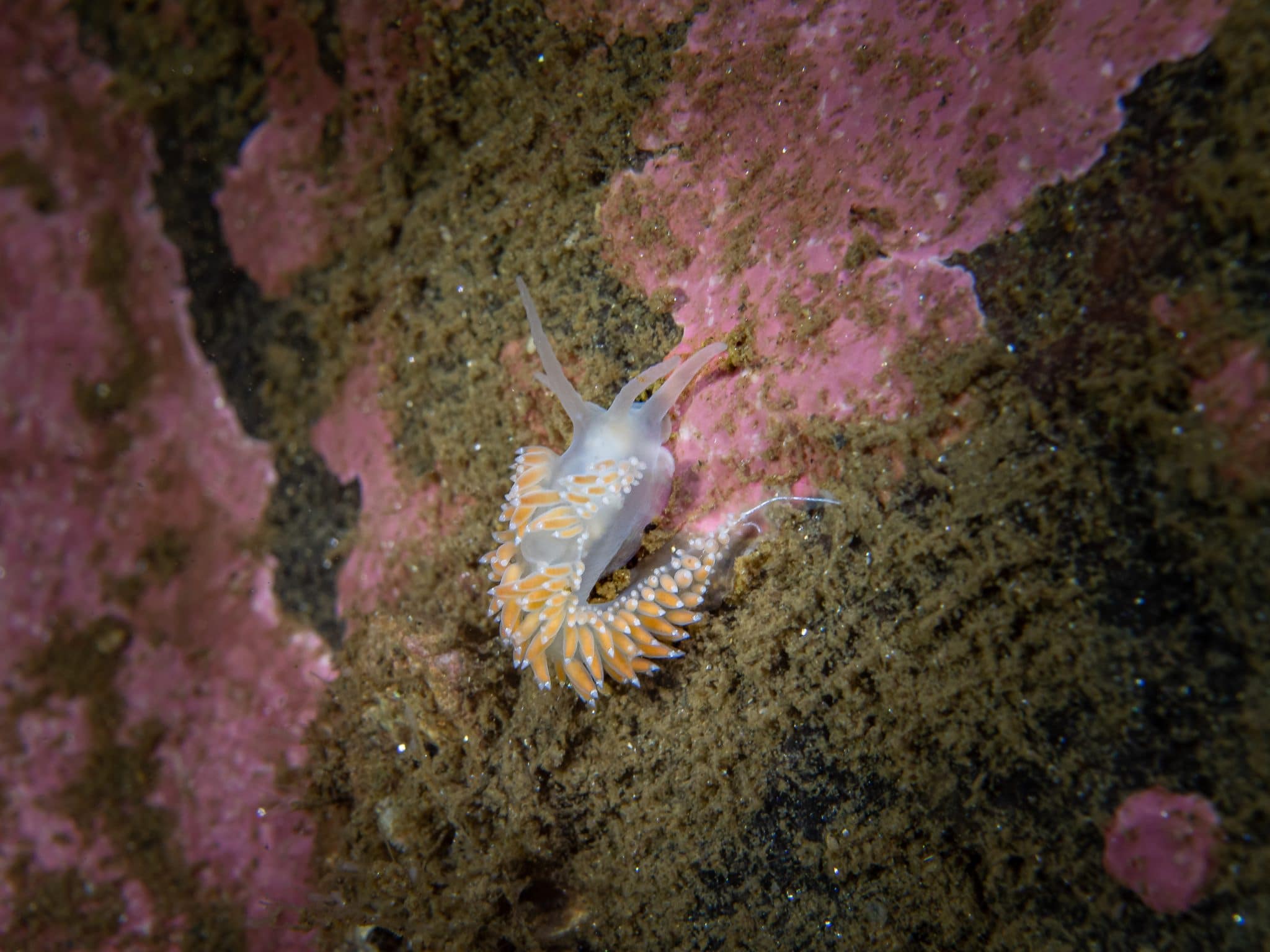
Diving a little deeper (below 20m) though you come across the great A-Frames, remnants of the old pier that lend their name to the site. Out of the gloom these huge structures very often suddenly appear (may have swam into them on one or two occasions… ) and you are welcomed by a vibrant cacophony of life. The frames are covered in anemones, star fish, deadmens fingers and if you’re really lucky the odd nudibranch! A dive around them never fails to disappoint and if you get a day with particularly good visibility the view from the seabed up to the top of them is truly spectacular.
If you are particularly keen to log some deeper dives, there is the option to head out further into the loch from the shore here and it’s easy enough to get +40m and its been known to see some pretty spectacular fireworks anemones at these depths.
29 Steps
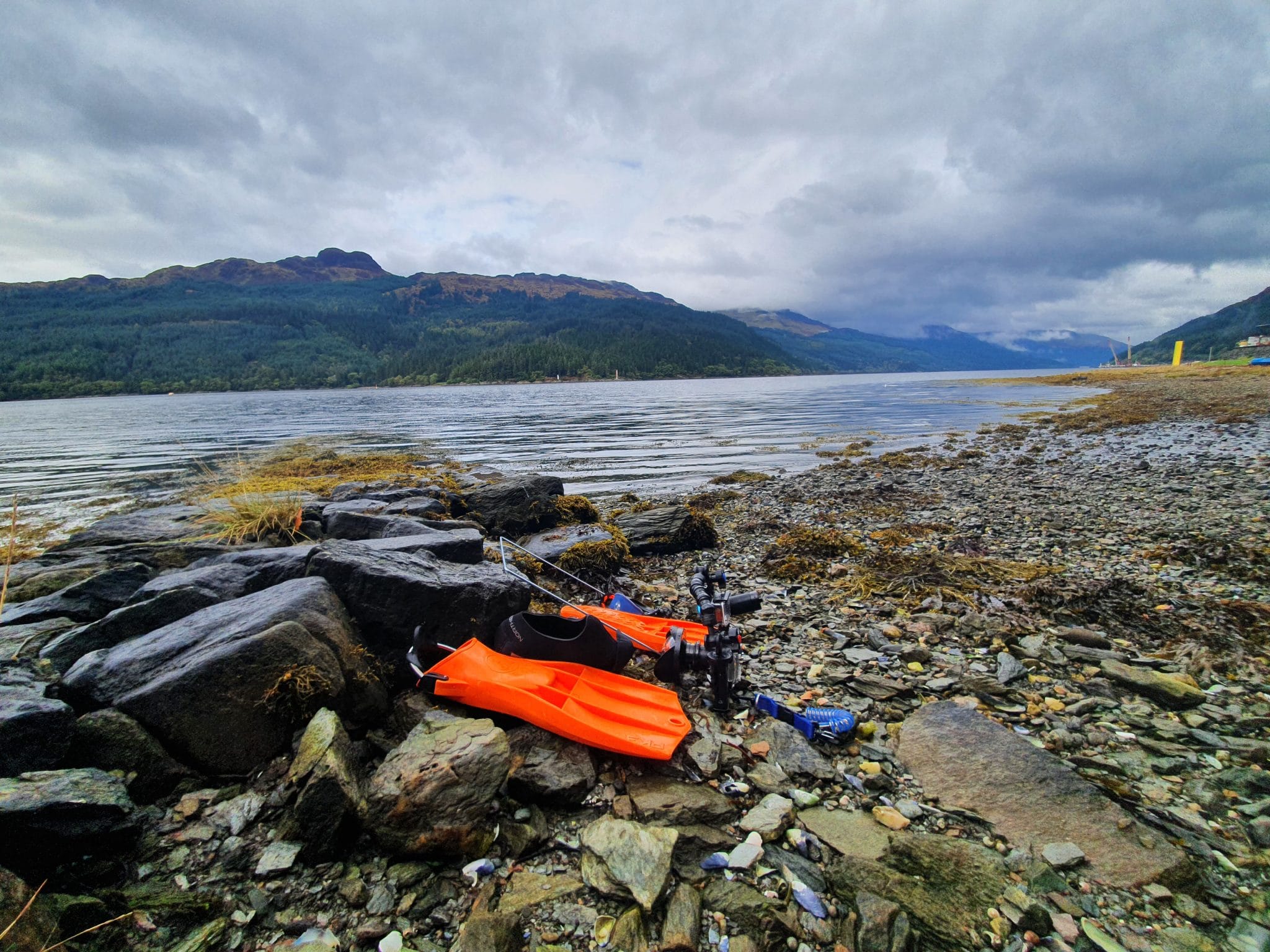
Just north of Finnart is the next dive site on our tour of Loch Long, in fact when I say just north, actually you can swim to it from Finnart… I may have got lost once and ended up at here, but that’s another story. Seen by regulars as more of a training site, and albeit maybe not quite as exciting as A-Frames, 29 Steps does offer a nice dive with a very easy entry and exit and pretty simple navigation.
Getting the name from the 29 steps (in fact there’s actually now only 26) that lead down to the beach from the road, the main hazard here is the steps themselves that can be quite slippy when wet, but apart from that once you reach the bottom you are met with a rather nice wee beach with the remnants of an old jetty stretching out into the water. The old jetty wall offers a convenient perch for dive gear and there is even a wee sheltered archway that can be used to escape the rain on a dreich Scottish dive day.
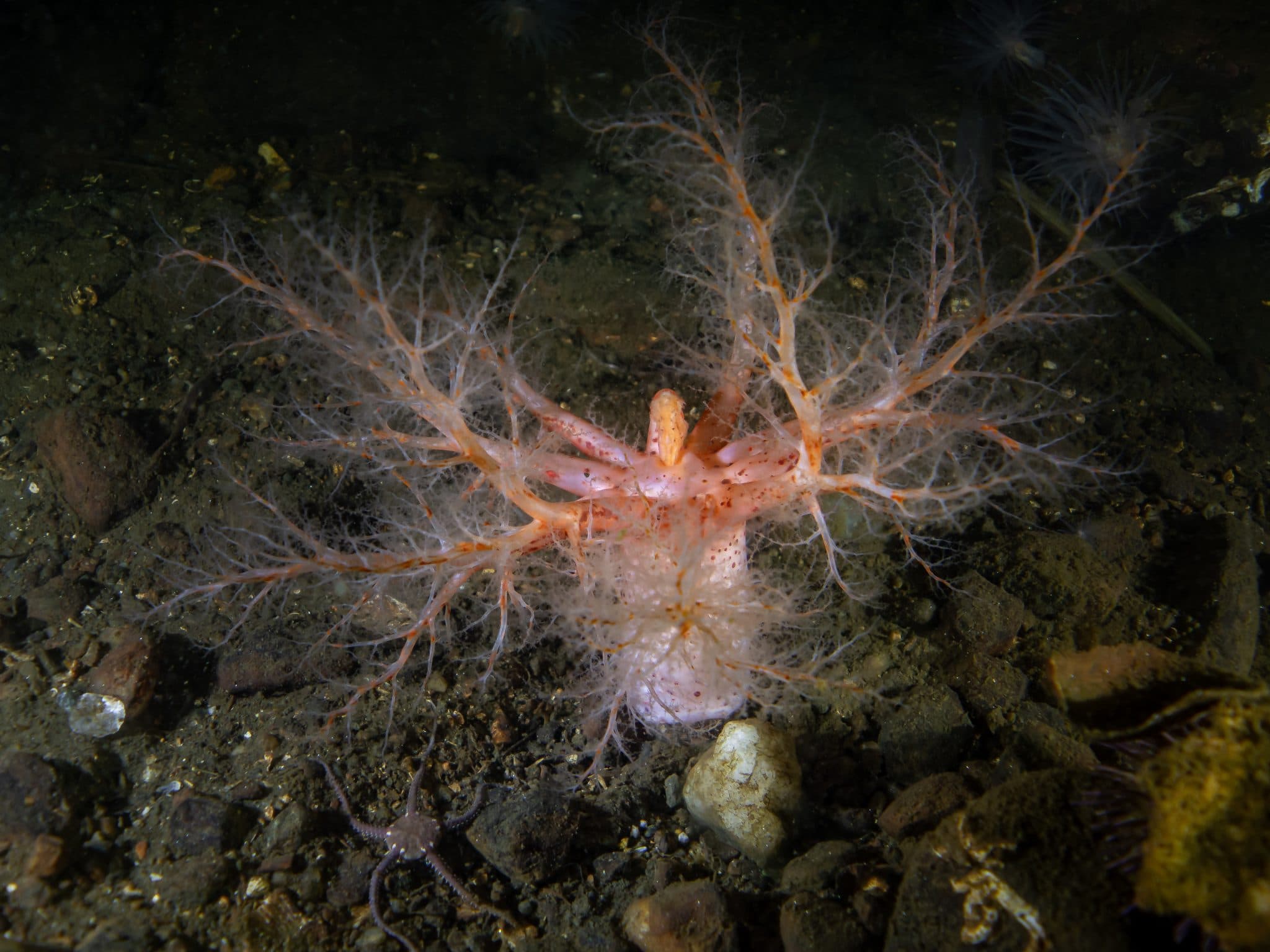
The main dive here is straight out from the beach down a gently slope to platform at around 9m which offers an excellent base for doing training and skills. Although not as much life on the platform (well it is regularly used for training), velvet and edible crabs can be found in and around it with a few other bits and pieces as well. From the Platform there is two options.
Option one is to follow the slope downwards as far as you like, where again, you will find the usual life of crabs, squat lobsters, starfish and even the odd fireworks anemone and langoustine at depth and then turning left to zig zag back up.
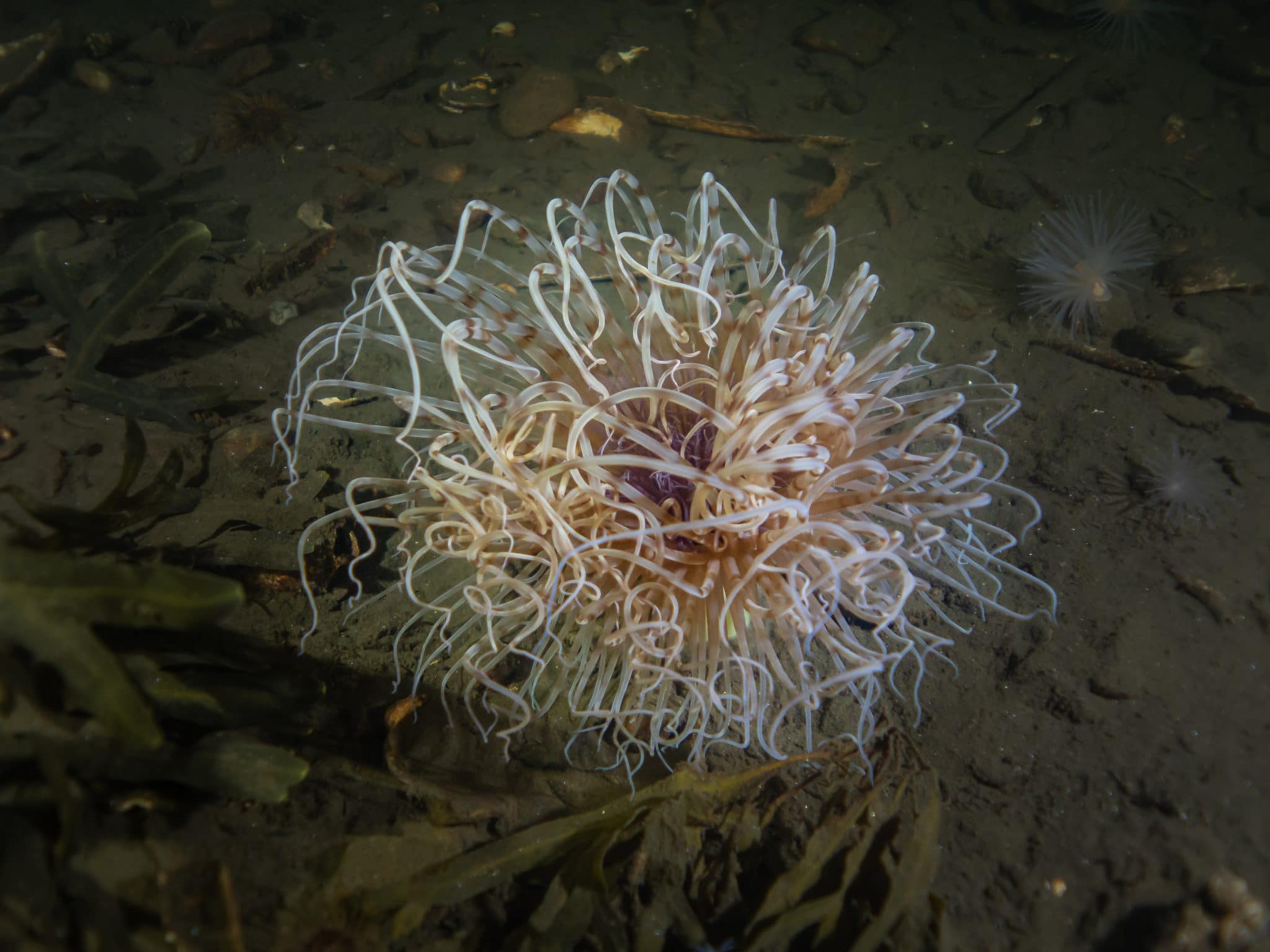
Option two, which can also be done along with option one is to continue down a little deeper from the platform and then bear left perpendicular to the slope. Finning along you will eventually come to the “wreck” of an old rowing boat which offers a nice habitat for the usual critters and even, if you’re really lucky, the odd flatfish in amongst the debris. On the way back to the entry/exit point, there is also an “artificial” reef of some old discarded dive tanks in the sand that also allows for a wee bit on investigation.
Maybe not quite as exciting a dive site as its near neighbour Finnart, 29 Steps is sometimes undervalued and does offer a nice alternative if you come to find A-Frames “mobbed” when you arrive, as it often can be at weekends.
Twin Piers
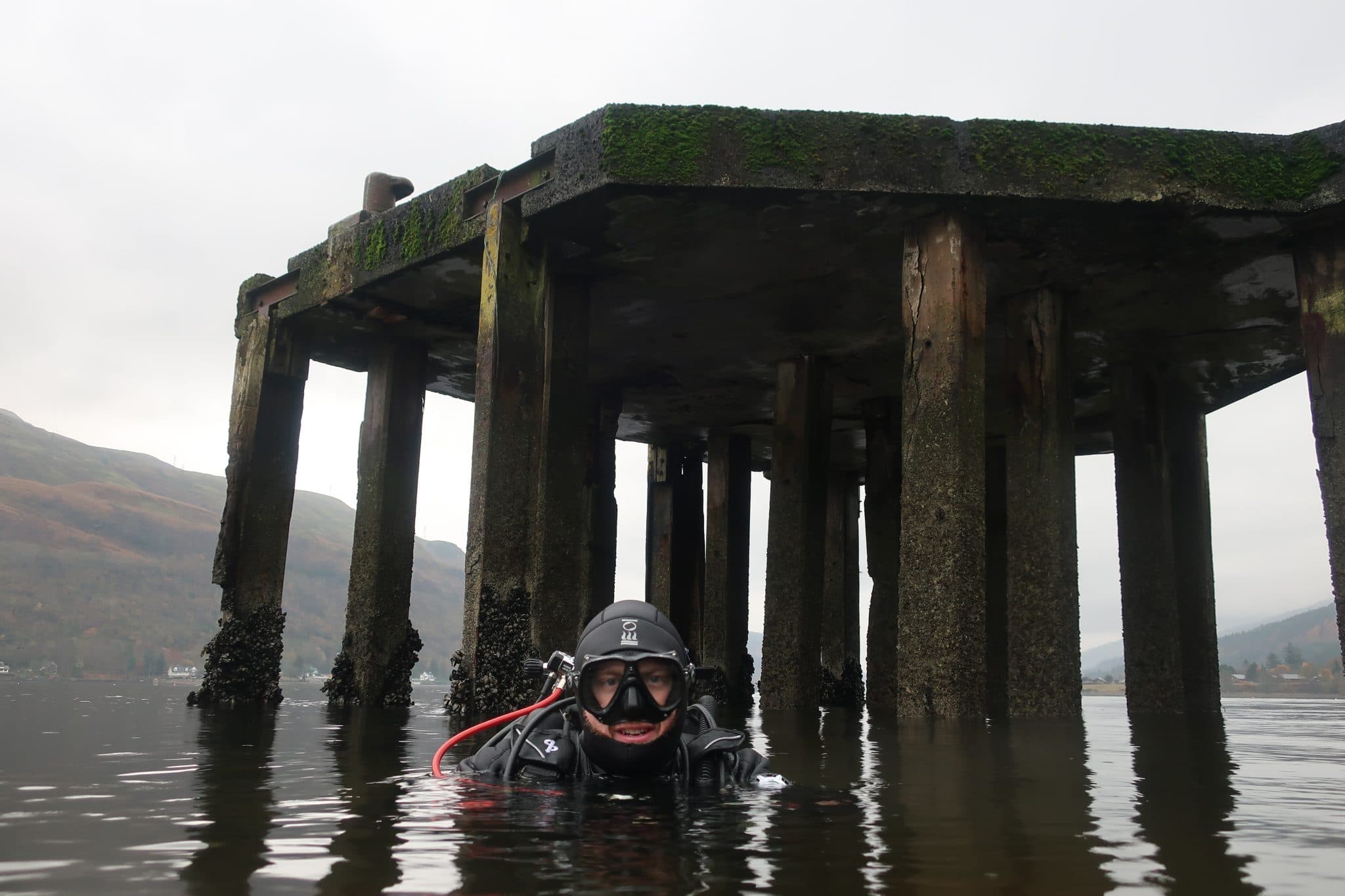
Heading to the top of the loch and round onto the west side you eventually come to the dive site Twin Piers. Once you arrive it’s pretty obvious where the name comes from. Sitting just off the beach is the remains of, funnily enough, two piers. Lying in the shadow of one of Scotland’s most popular hill walks the Cobbler, both Twin Piers (and Conger Alley) can very often offer sights just as spectacular beneath the waves as you can expect from the mountain that towers over it.
Parking for Twin Piers can be a little bit tricky if you happen to turn up on a particularly busy day. This requires driving ever so slightly past actual entry point and onto the grass verge on the side. This also leads to one of the main hazards of Twin Piers the extremely busy, and fast, road it sits on. There is an excellent path which leads back to the entry, but I would still strongly advise care be taken when walking to the site with heavy gear as both lorries and coaches often travel at speed along the road. The beach itself actually sits on a lower level to the road/parking area and so the second main hazard of the site is found. A ladder has been place and secured from the original “entrance” of the pier and a handle has also been drilled into the wall to help with the climb down. In all honest it is not a major issue, but is still worth mentioning.
Ok, so onto the diving! Twin Piers is an excellent site for divers of all abilities and navigation is pretty straight forward. From the beach head straight out between the two piers and drop down. On the slope you’ll be met with a carpet of discarded bivalve shells which is pretty impressive in its own right. Continue down the slope to anywhere between 10 to 15m or so and then bear left perpendicular to the slope. If you are lucky you will eventually hit the chassis and axels of an old truck which fell off the pier.
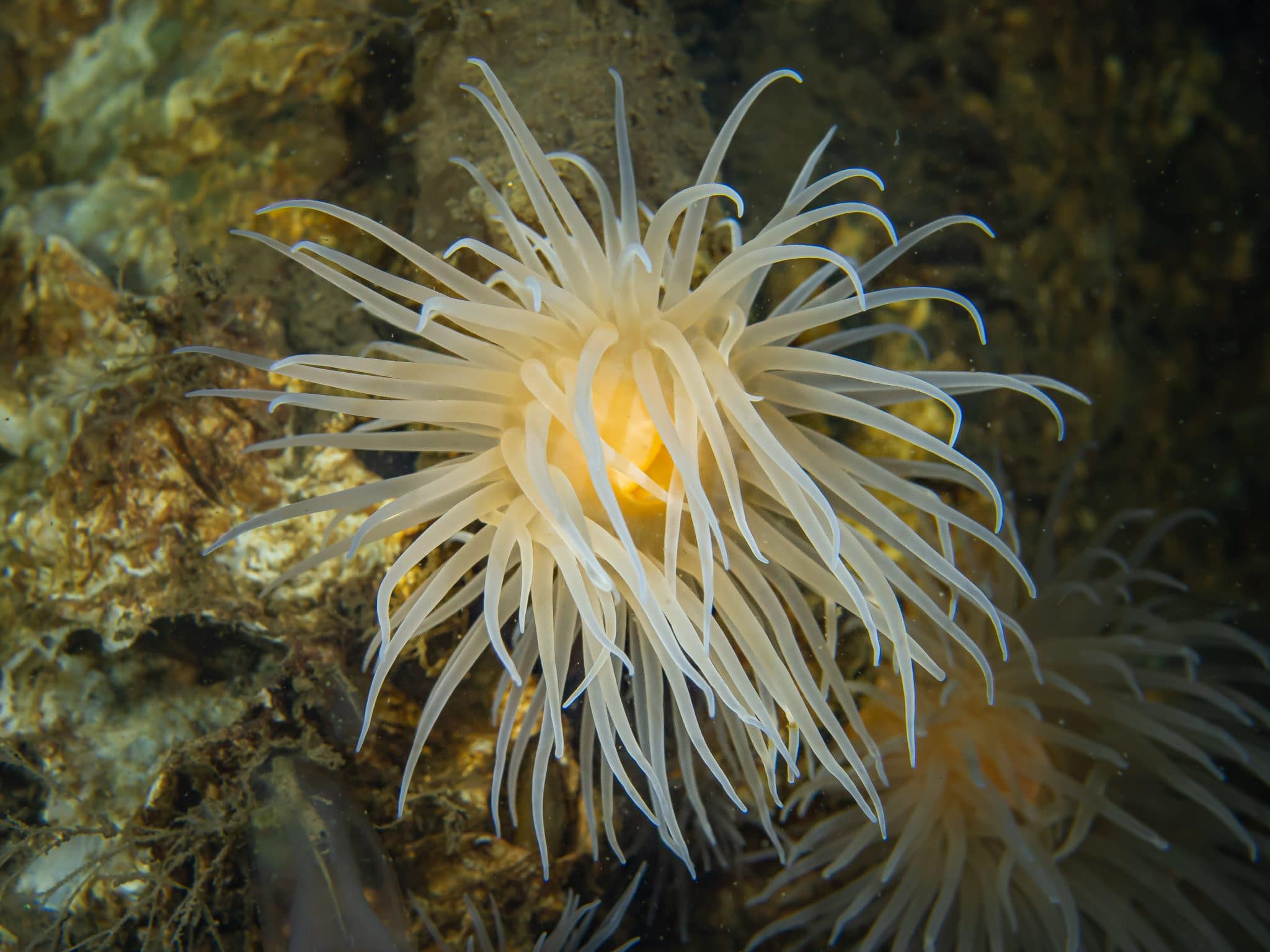
From here I’d suggest heading down to between 15 and 20m and continue to swim perpendicular to the slope until you eventually reach a rather excellent rocky reef. The boulders here are huge and offer a fantastic habitat to a whole array of life from the usual crabs, squat lobsters, anemone, starfish, deadmens fingers, etc. But the real attraction of Twin Piers is the possibility of seeing conger eels and even the odd lobster. These make their homes in the larger cracks in, around and under the huge boulders. Zig Zag up the reef and then once you’ve reached the time for a return simply retrace your steps… or should that be finstrokes? Depending on the tide state, if you come up to around 6m and swim back along you can’t fail to hit the legs of the piers, which offer a rather nice final exploration of the site during your safety stop.
On a nice day (both above and below the water), with the sun breaking through the water around the piers themselves are absolutely spectacular. The legs are awash with vibrant colourful life ranging from starfish to anemones and even the odd nudibranch if you’re lucky!
Conger Alley
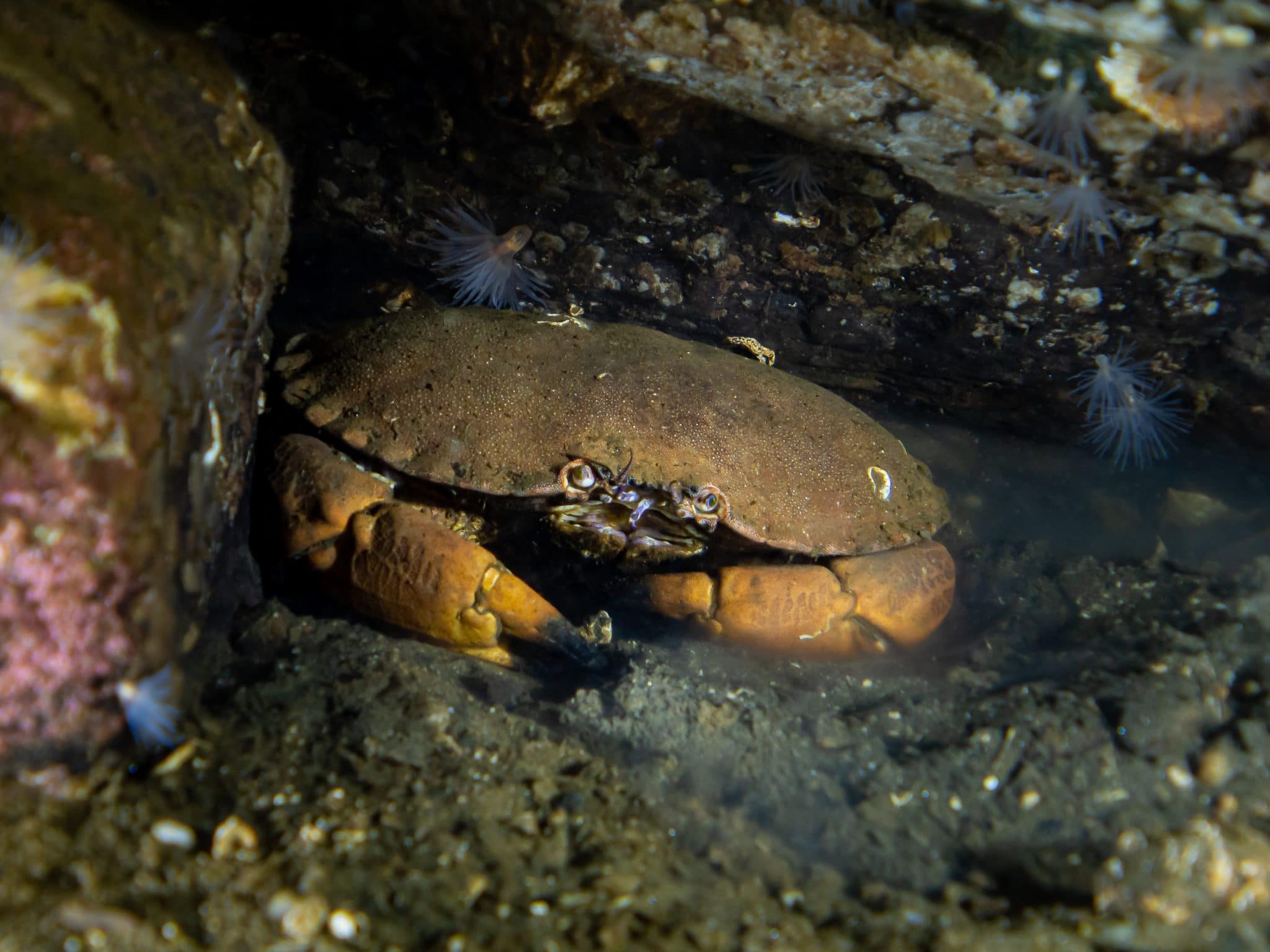
Wonder what we might find here? Heading just a couple of minutes south down the road from Twin Piers along the west side of Loch Long you eventually come to my favourite dive site in the loch. Now blink here and you could very well miss the entry and although I did mention the road as a hazard at Twin Piers, on the grand scheme of things it wasn’t a huge concern, however here at Conger Alley you do need to really be careful.
Parking for the dive site is actually on the opposite side of the road to the loch in what can only be loosely described as a small muddy layby. Now at this particular spot there is only really enough room for three cars at a push, but on the way to the site you’ll have passed a bigger, “proper” layby that can be used instead, however parking here will involve a wee bit of a longer walk back to the site, but it is worth it! Crossing the busy road does require care though so I would strongly suggest carrying your kit down to the beach and getting kitted up here as opposed to at the car and then crossing the road with hood, etc on. Thankfully the beach itself offers some rather strategically place rocks that can be used to prop gear on and even a very handy seawall that helps “step into” a twinset.
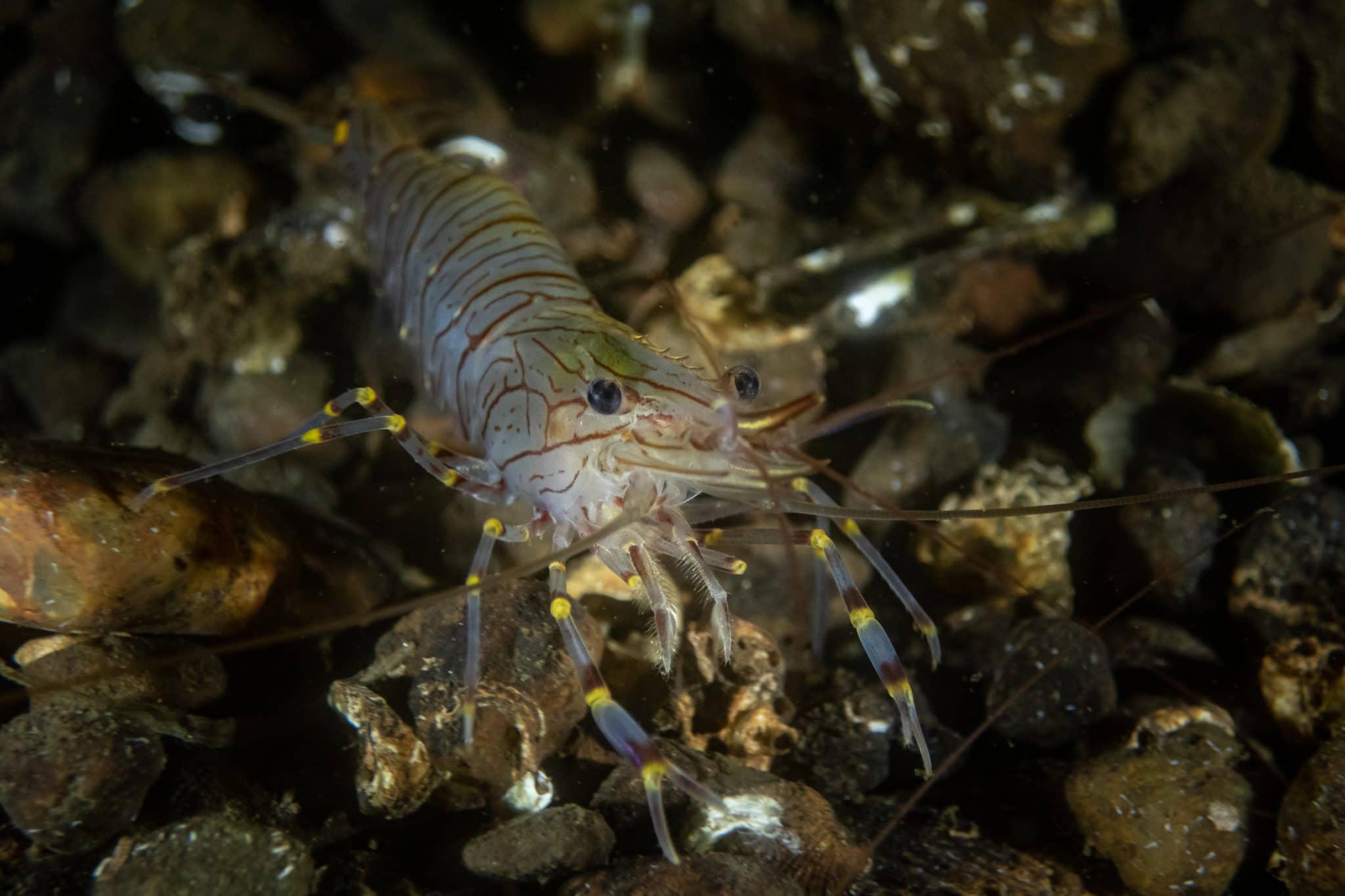
Again like all the sites I’ve discussed the entry is really easy here. Simply walk into the water, drop down and follow the slope to I would suggest, about 12 to 15m and swim left for around 4mins. You eventually come to the edge of a rather large rocky reef and from here it is totally up to yourself how deep you want to go. If your certification allows it I would recommend dropping down the reef to around 26 to 30m and then slowly zig zagging your way back up it taking your time to look in all the cracks and crevices.
I genuinely don’t think I’ve ever had a bad dive at Conger Alley and the life on the reef is unbelievable! There’s obviously the usual crabs, starfish, anemones, etc, but as the name might suggest there is a really good number of congers, and lobsters, to be found in the larger holes. Take your time to search each as they can be a little shy, but they are there. It’s also not uncommon to find the odd octopus lurking around on the rocks, so look carefully.
There’s also an abundance of fish as well from flatfish to sometimes rather colourful wrasse. Again, like at Twin Piers, gradually come up the reef and then once you’ve reached the end head back along the slope in the opposite direction to you came and you’ll eventually reach the exit.
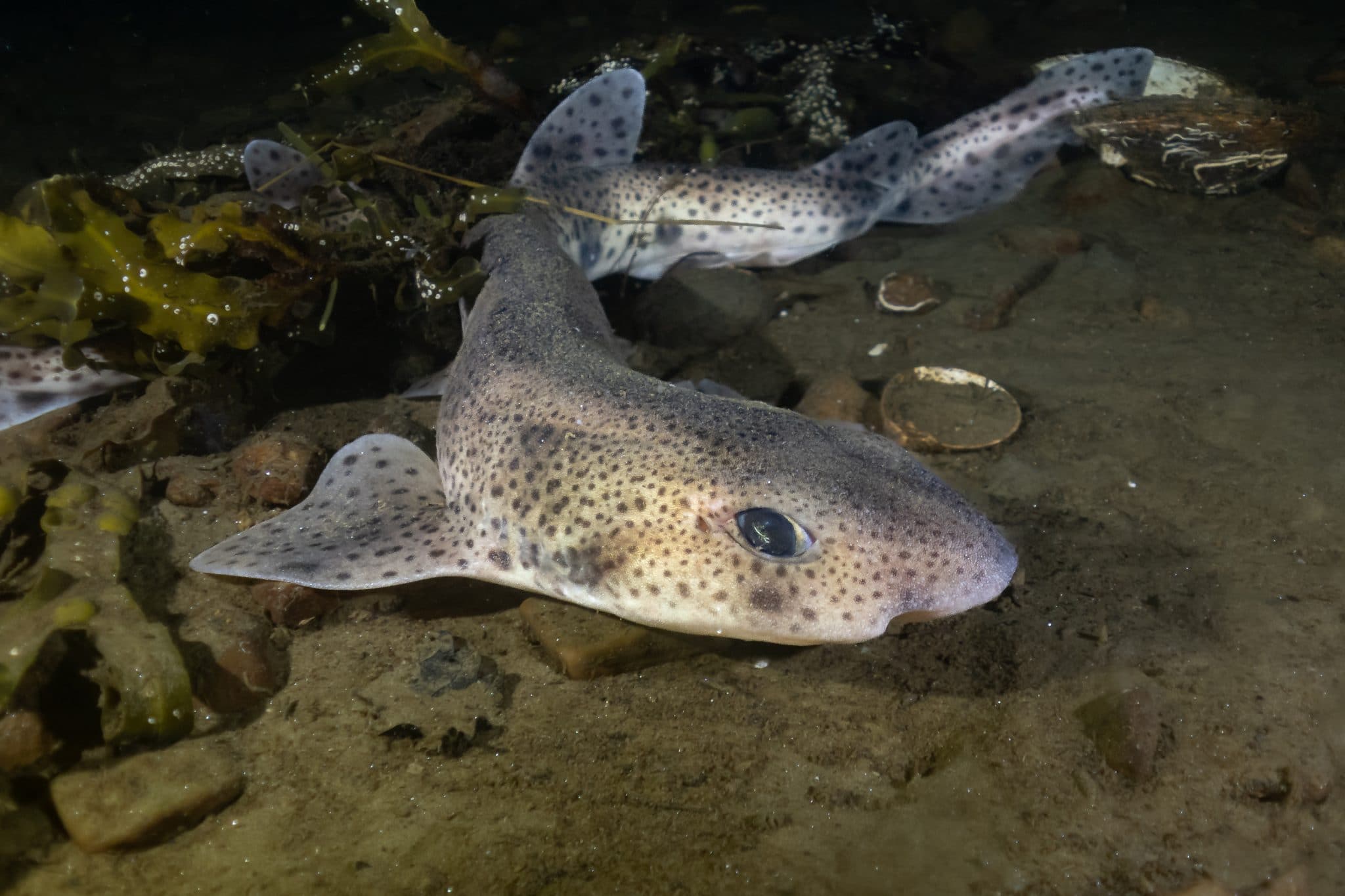
Obviously these four sites are probably the most popular and accessible to the vast majority of divers, but they really only offer a small taste of what this 20 mile loch has to offer. From the shore there is up to approximately nine dives to choose from on Finstrokes and if you have access to a boat, or are able to book onto a charter such as Wreckspeditions based in Dunoon, there is the potential for even more sites to be discovered.
With such close proximity to Glasgow and situated just next to Loch Lomond, and all the amenities it has to offer, there is also the possibility of overnight stays in campsites and lodges in the surrounding area for those coming from further afield. Loch Long offers divers an abundance of choice within easy reach that can sometimes can be overlooked and underappreciated.
For more from Ross, follow him on Instagram @underwater.ross and on Twitter @outdoorsross.
News
Book Review: Fire on Monroe Bravo by Fred Lockwood

Fire on Monroe Bravo is the latest book in the Jack Collier series by Fred Lockwood. Our story begins with our lead characters, Jack and Sandro, owners of Marine Salvage & Investigation Company, arriving on the Monroe Bravo Oil & Gas Platform in the North Sea. Having secured a contract for their vessel the MV Stavanger to act as support ship to the platform for TransGlobal Oil, our protagonists are on a celebratory visit.
However almost as soon as they arrive a series of explosions rock the platform, causing huge damage, loss of life and the very real danger of a massive human, ecological and financial disaster.

As the danger mounts for both our heroes and the surviving workers, Jack and Sandro will have to escape the inferno, all while trying to save the platform and the men still trapped unable to help themselves.
The disaster sets the scene for the unfolding story lines following the fate of the platform and our main characters, the police investigation into a suspected terrorist act and the actions of TransGlobal Oil as they attempt to navigate the pubic outcry and financial repercussions.
In his eighth book, Fire on Monroe Bravo, Fred Lockwood delivers an explosive thriller, with plenty of above and in-water drama, and our heroes fighting for survival, what more can you ask for?
We thoroughly recommend this read and look forward to the next in the series. For more information about his book series, you can check out the reviews of his previous books here on Scubaverse.
- Title: Fire On Monroe Bravo
- Author: Fred Lockwood
- ISBN: 979-8325324536
Available in a paperback version and for Kindle from Amazon and book stores.
Blogs
Alonissos: The complete diving destination (Part 1)

In June we were incredibly fortunate to be invited to dive in Alonissos, a small Greek Island in the Sporades island chain located in the North Aegean Sea. While I have long been a big fan of the Greek Islands as a great holiday destination, I had not had the opportunity to do any diving on previous visits and Mike and I were extremely excited to see what Alonissos had to offer both above and below the surface!

The Sporades are easily accessible via the airport in Skiathos (the first island in the chain), which is served by Jet2 flights from all major UK airports from May through October. Numerous ferries and charter boats make island hopping from Skiathos Town a breeze. After an hour boat ride, the picturesque port of Patitiri was a wonderful introduction to Alonissos, where we were met by our gracious hosts Kostas of Albedo Travel and Dias of Alonissos Triton Dive Center. Mike and I were delighted to be staying at the Paradise Hotel, aptly named for its stunning views over the sea and great location for walking to the waterfront.

Alonissos is beautifully situated in the National Marine Park of Alonissos and the Northern Sporades, the largest marine protected area in Europe. The surrounding seas offer fabulous marine life, including incredibly rare species such as the Mediterranean monk seal. They boast deep walls covered in gorgonians and sponges, stunning topography with caverns, swimthroughs and pinnacles, and the first accessible ancient shipwreck from 500BC!

In locations where historical sites have been reported, the waters are largely restricted, but with collaboration between government, underwater archeologists and dive centres, incredible underwater museums are being created for a truly unique diving experience. Alonissos is home to the first of these, the Ancient Shipwreck of Peristera Accessible Underwater Archeological Site. The chance to dive into history (along with reports of healthy reef life and amazing underwater topography) meant Mike and I were keen to get in the water.

Our introduction to the diving around Alonissos was at the Agios Georgios Pinnacles, in the channel between Alonissos and Skopelos. This fantastic site was named “The Chimney,’ and proved to have a huge amount to see. We got to a decent depth here (over 25m), and marvelled at a colourful reef wall with a wonderful swim through whose rocky walls were absolutely covered with life. As well as brilliant topography there was no shortage of macro life here. We saw numerous nudibranchs, five different species in total. The second dive at Mourtias reef nearby was a shallower dive along a nice wall with lots of crevices. Several moray eels and grouper called this site home. We enjoyed looking in the crevices for lobster and smaller benthic life, such as cup corals and tunicates.

Our itinerary allowed us two dives a day with afternoons left to explore the island with our hire car and evenings to enjoy the famous Greek hospitality. This proved to be a lovely mix of in-water and land based diversions.

The next days diving to the Gorgonian Gardens and Triton’s Cave was to be even better! These two stunning sites are nothing short of fabulous. The Gorgonian Gardens was a deep wall near to the Agios Georgios islands. The ever-present currents in this deep channel meant that the sea life was amazing … the namesake Gorgonian sea fans dotted the wall at a depth of 30 to 50 meters, getting ever larger the deeper we went. Above 30m was by no means less beautiful, with sponges, corals, scorpionfish, moray eels and some rare and colourful nudibranchs.

The second shallower dive of the day was to Triton’s Cave or the Cavern of Skopelos, on the east side of that island. The spectacular rock formations had wild striations both above and below the water making a truly epic topography. The cavern entrance was at 14m, and big enough for a buddy pair, winding up to 6m and passing two beautiful windows out into the blue. Emerging from the cavern, the light at the shallower depths and the incredible rock formations made for a fantastic gentle swimming safety stop and we all surfaced by the boat with massive grins.

Check out our next blog :Alonissos: The complete diving destination (Part 2)” to hear about our amazing dive on the 2500 year old Peristera Wreck!
Thanks to:
Alonissos Triton Dive Center https://bestdivingingreece.com/
Albedo Travel https://alonissosholidays.com/activities/
Paradise Hotel https://paradise-hotel.gr/
Alonissos Municipality https://alonissos.gr/en/
-

 Blogs2 months ago
Blogs2 months agoDiving With… Nico, Ocean Earth Travels, Indonesia
-

 News1 month ago
News1 month agoMurex Bangka Announce New Oceanfront Cottages & Beachfront Dining
-

 Blogs2 months ago
Blogs2 months agoA new idea in freediving from RAID
-

 Marine Life & Conservation1 month ago
Marine Life & Conservation1 month agoIceland issue millionaire whale hunter a licence to murder 128 vulnerable fin whales
-

 Marine Life & Conservation2 months ago
Marine Life & Conservation2 months agoThe Shark Trust Great Shark Snapshot is back
-

 News3 months ago
News3 months agoCharting New Waters; NovoScuba Goes Global with the Launch of their Revolutionary Dive Training Agency!
-

 Gear News1 month ago
Gear News1 month agoNew Suunto Ocean – a dive computer and GPS sports watch in one for adventures below and above the surface
-

 Marine Life & Conservation Blogs2 months ago
Marine Life & Conservation Blogs2 months agoBook Review: Plankton















